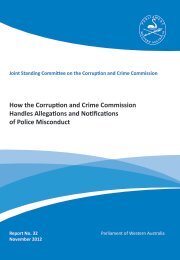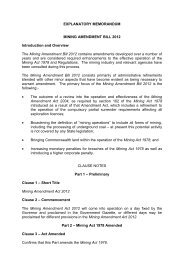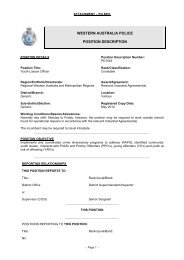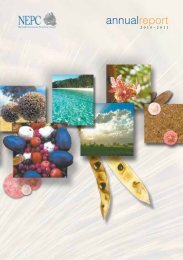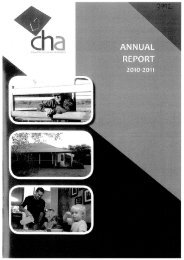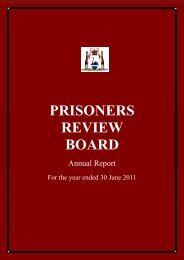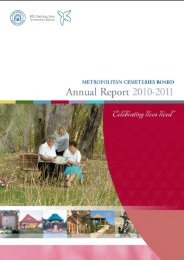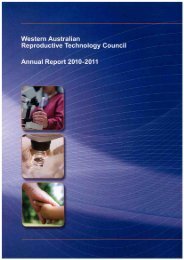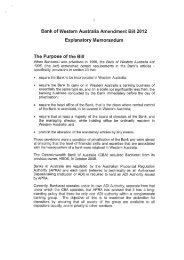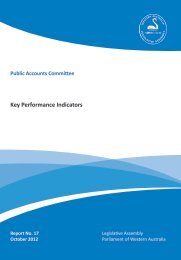Challenger TAFE | Annual Report 2006 - Parliament of Western ...
Challenger TAFE | Annual Report 2006 - Parliament of Western ...
Challenger TAFE | Annual Report 2006 - Parliament of Western ...
Create successful ePaper yourself
Turn your PDF publications into a flip-book with our unique Google optimized e-Paper software.
<strong>Challenger</strong> <strong>TAFE</strong> | <strong>Annual</strong> <strong>Report</strong> <strong>2006</strong> 41<br />
The percentage <strong>of</strong> <strong>Challenger</strong> respondents who indicated that they achieved or partly achieved their main purpose in studying<br />
increased by 2.3% on the previous measure taken in 2003. This is one indicator <strong>of</strong> the students’ degree <strong>of</strong> satisfaction with their<br />
training program and its relevance. In 2005, 81% <strong>of</strong> <strong>Challenger</strong> <strong>TAFE</strong>’s graduates (compared with 84% <strong>of</strong> <strong>Western</strong> Australian<br />
<strong>TAFE</strong> graduates and 86% <strong>of</strong> Australian <strong>TAFE</strong> graduates) achieved or partly achieved their main reason for studying.<br />
72% <strong>of</strong> the student weighted population indicated their main reason for studying was employment-related, a decrease <strong>of</strong> 1.17%<br />
on the previous measure completed in 2003 on the 2002 cohort. Within that response, the most frequently given single reason<br />
was: to get a job (24%) to improve general education skills (14%) the skills being a requirement <strong>of</strong> the job (12%) and requiring<br />
extra skills (12%). 31% <strong>of</strong> the respondents identifi ed that they had sought to improve their work circumstances through a different<br />
career or extra skills or a better job or promotion and 6% indicated that their reasons included improving skills for starting or<br />
building their own business.<br />
Methodology: The measures were drawn from the survey report titled “Student Outcomes Survey <strong>Western</strong> Australian Institute<br />
<strong>Report</strong> for <strong>Challenger</strong> <strong>TAFE</strong> November 2005” that provides comparative data on an institution, State and national basis.<br />
Derivation: In each <strong>of</strong> the Student Outcomes Surveys (previously called Graduate Destination Surveys) conducted since 1997, the<br />
same question regarding the main reason for doing the course was asked <strong>of</strong> graduates and the same rating scale used enabling<br />
maintenance <strong>of</strong> trend data to 2003. To 2003, the measure was re-based and refl ected as a percentage <strong>of</strong> those who answered<br />
“Yes” or “Partly” as a proportion <strong>of</strong> all those who gave a valid response to the question. In 2005 the exact number <strong>of</strong> respondents<br />
was not available and results were provided as weighted samples.<br />
Statistical Details: A weighted sample <strong>of</strong> 760 <strong>Challenger</strong> <strong>TAFE</strong> graduates responded to a question about whether they achieved<br />
their main reason for undertaking a course. The estimated <strong>Challenger</strong> graduate student population was 5339. A standard error<br />
measure was provided based on the response population for each question. The standard error was +/- 2.6 with a confi dence<br />
level <strong>of</strong> 95%.<br />
Explanation: The results indicated that most <strong>TAFE</strong> graduates, including those from <strong>Challenger</strong> <strong>TAFE</strong>, were studying for vocational<br />
reasons in 2004 and the majority <strong>of</strong> these students sought to get a job. Note that national data on graduate satisfaction was not<br />
available prior to 2000 nor in 2004 based on the 2003 graduate population nor <strong>2006</strong> based on the 2005 graduate population.<br />
The lower result for <strong>Challenger</strong> <strong>TAFE</strong> compared with the state and national fi gures may relate to an older pr<strong>of</strong>i le for its students.<br />
Older graduates experience less success when seeking their desired employment. <strong>Challenger</strong> <strong>TAFE</strong>’s Internal measures <strong>of</strong> levels<br />
<strong>of</strong> student satisfaction remains very high. Please see Figure 8.17<br />
Table 8.8: Graduates Achievement <strong>of</strong> Main Reason for Study 2001-2005<br />
2001 2002 2003 2004 2005<br />
<strong>Challenger</strong> <strong>TAFE</strong> 77.99% 81.16% 79.70% N/A 81.00%<br />
<strong>Western</strong> Australia 76.33% 76.98% 77.96% N/A 84.00%<br />
Australia 78.96% 77.98% 78.80% N/A 86.00%<br />
Table 8.9: Graduates’ Main Reasons for Study 1999-2005<br />
Graduates’ Main Reasons for Study<br />
1999 2000 2001 2002 2003 2004 2005<br />
Employment- related 73.60% 73.60% 71.50% 71.30% 73.17% N/A* 72.00%<br />
To enter further study 9.30% 9.80% 10.00% 9.10% 9.20% N/A* 9.00%<br />
Personal or Interest 13.90% 14.10% 12.70% 16.80% 14.98% N/A* 19.00%<br />
Other Reasons or Unknown 3.20% 2.50% 5.80% 2.70% 2.65% N/A*



